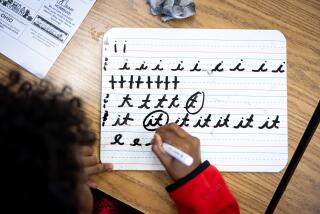Getting Ahead by Getting Organized
- Share via
Last year, 12-year-old Kyle Rohrbach scribbled his assignments on scraps of paper and stuffed his crumpled homework into his backpack. Inevitably, he forgot what he had to do and often turned in his work late.
This year, he hands in his homework on time and never forgets a test. Kyle said that’s because of his red and white agenda book.
Adults have relied on organizers for years. They use them to record appointments and addresses, things to do and things to buy. Now, their children are doing the same. They are getting their busy school and social lives in order by noting everything in day planners.
Kyle, an articulate seventh-grader at Redwood Middle School in Thousand Oaks, writes his homework assignments, long-term projects and test dates in his planner. He also jots down school dances, student government activities and vacation days.
“I used to be all messy and I didn’t really pay attention to writing down my homework,” he said. “But this has kept me on track. Now I always have my homework and materials with me.”
Schools throughout Southern California are increasingly requiring their students to carry organizers--complete with daily and monthly calendars, lists of school rules and places to write personal goals. Principals, teachers and parents credit the agenda books with teaching students responsibility, organization and time management.
*
The 1,750 students at Lathrop Intermediate School carry agendas, which Assistant Principal Dawn Miller said help improve student achievement. “Any type of tool that helps students become more organized is important,” she said. “These are the habits students need to learn now that can really help them later.”
Educators say the day planners also are an important communication tool for parents and teachers. When their children get to middle school, parents often reduce their participation. So the organizers are a way to keep parents in the loop. There is space for teachers to write comments about students’ work habits, attendance and attitude, and for parents to sign when their children complete daily assignments.
The organizers started appearing in students’ backpacks at a few schools in the late 1980s. This year, dozens of local middle schools purchased the agendas for their students. The books cost between $3 and $5 apiece and are customized for each campus. In some schools, the parent-teacher association picks up the tab.
One of the biggest producers of organizers is Irvine-based Premier School Agendas. In 1988, the company sold 8,000 agendas, primarily in Southern California. In 1999, it sold 15 million around the world.
“These got introduced to schools and have been right on the money in terms of getting kids organized,” said Jim Newbold, regional manager for the company. “It’s not going to change every child’s life, but it’s a first step. It’s a $4 investment for a kid.”
Newbold estimates that 60% of middle schools, 45% of high schools and 25% of elementary schools in Southern California buy from Premier School Agendas, and rival companies serve many other schools. All of Ventura County’s large districts--including Simi Valley Unified, Conejo Valley Unified, Oxnard Elementary and Ventura Unified--use student day planners. And in Los Angeles Unified, about one-third of all schools give their students the agendas.
Parents and teachers say the books are the most popular in middle school because that is the most dramatic transition time for students, when preteenagers start shifting class schedules and have a lot more to remember.
“When the kids get to middle school, there is so much going on, and they don’t have anybody to run around after them to check what they are doing,” said Lindsay Timpson, whose two sons and daughter have attended schools in the Conejo Valley Unified School District. “They take a tremendous leap in terms of responsibility then, and this really makes things easier for them.”
In the last few years, more elementary schools and high schools have purchased the agendas.
“It’s just a real good check to make sure students get their assignments written down properly,” said Jim McAleney, assistant principal at Buena High School in Ventura. “Students are held accountable. And we’re teaching them lifelong skills.”
In most cases, agenda books contain a school’s rules, a campus map, a calendar and a letter from the principal. Books also have maps and reference pages that teach students the basics: spelling rules, parts of speech, geometric shapes, state capitals, bibliography formats.
Some agendas also include study and success tips for students: Neatness counts. Re-read class notes every evening. Break big assignments into little chunks to make them easier. Get in the habit of studying at a regular time.
*
At some schools, the organizers are also used as hall passes; students have to carry them everywhere they go. That way, principals can track how often students are leaving class. And students think twice before just throwing an organizer into the trash can, because a student who wants to go to the bathroom, for instance, has to have an organizer.
Whenever Redwood Principal Tim Carpenter meets with parents to talk about struggling students, the first thing he does is ask the students to pull out their organizers. If the pages are blank, he said, that explains why they haven’t been keeping up with their work. “When we get them back using the assignment notebook, we see immediate results,” he said.
Conejo Valley Unified parent Timpson said she likes being able to read exactly which assignments her children are expected to complete and when they are due. She said the agendas helped whip her sons into shape because both she and the teacher were keeping tabs on their progress.
“I think it’s invaluable,” she said. “It just really helps get the kids into some kind of routine.”
More to Read
Sign up for Essential California
The most important California stories and recommendations in your inbox every morning.
You may occasionally receive promotional content from the Los Angeles Times.













